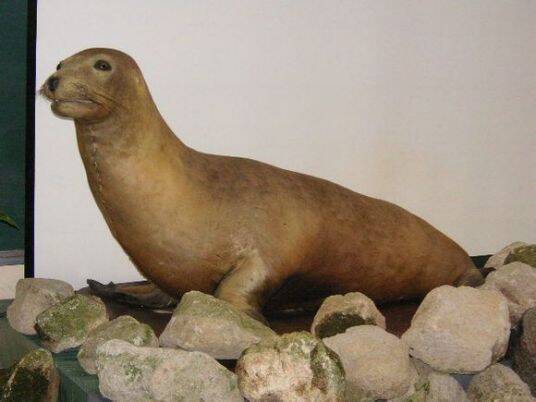Zalophus japonicus
IUCN
LCBasic Information
Scientific classification
- name:Zalophus japonicus
- Scientific Name:Zalophus japonicus
- Outline:Carnivora
- Family:C.S.lion
Vital signs
- length:1.64-2.5m
- Weight:300-560kg
- lifetime:No verification information
Feature
Larger than the California sea lion, extinct
Distribution and Habitat
Japanese sea lions are mainly distributed in the coastal areas of the Sea of Japan in the Japanese archipelago, the Korean Peninsula, the Kuril Islands, and the southern tip of the Kamchatka Peninsula.
Ancient Korean documents record the presence of sea lions and spotted seals in the Bohai Sea, the Yellow Sea, and the Sea of Japan. Some places along the coast of Japan are also named after sea lions, such as Sea Lion Rock and Dog Barking Osaki.
Appearance
Male Japanese sea lions are dark grey, weigh 450-560 kg, and are 2.3-2.5 meters long, larger than male California sea lions. Female Japanese sea lions are significantly smaller, only 1.64 meters long, and have lighter bodies.
Details
Japanese sea lion, Zalophus japonicus (Peters, 1866), is an extinct species of sea lion in the genus Zalophus of the family Eurasidae. Before 2003, Japanese sea lions were considered a subspecies of the California sea lion, but later it was pointed out that Japanese sea lions and California sea lions have different habitats and behaviors, so they were classified as independent species.

Japanese sea lions usually breed on flat and open beaches, but rarely on rocky land, and mostly in caves.
Many Japanese sea lion bones have been excavated from shell mounds in the Jomon period of Japan. The 18th century Japanese encyclopedia "Wa-Han Sancai Tuhui" records that their meat is not tasty, and their fat is used to light lamps. Precious oil can be extracted from their skin, their internal organs can be made into precious medicinal materials, and their fur can be made into leather goods. In the 20th century, they were hunted by circuses.
In the early 1900s, Japanese fishing records showed that 3,200 sea lions were hunted. By 1915 and the 1930s, due to overhunting, the number of hunts dropped to 300 and dozens respectively. The Japanese sea lion eventually became extinct in the 1940s. 16,500 Japanese sea lions were hunted, which was enough to drive them to extinction. In addition, the submarine warfare of World War II also destroyed their habitat. In the 1950s, the Korean Coast Guard reported the discovery of sea lions. The last confirmed discovery was of a baby sea lion captured in 1974 near Rebun Island, north of Hokkaido.
There are several specimens of Japanese sea lions in Japan and the Netherlands. The British Museum has fur and four skulls of Japanese sea lions.
The Korean Ministry of Environment has initiated a search for and reintroduction of sea lions into the country, and the National Institute of Environmental Research is currently conducting a feasibility study. In 2007, North Korea, South Korea, Russia and China formed a joint research team to search for sea lions in Chinese and Russian waters and then introduce them to the waters of the Sea of Japan. If they cannot be found, the Korean government plans to ship California sea lions from the United States.
Protect wildlife and eliminate game.
Maintaining ecological balance is everyone's responsibility!








